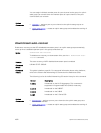into a keepalive down state that does not clear in a few seconds, then performing
shutdown - no shutdown sequence on one end should bring both ends back to
up.
tunnel-mode
Enable a tunnel interface.
.
Syntax
tunnel mode {ipip | ipv6 | ipv6ip}[decapsulate-any]
To disable an active tunnel interface, use the no tunnel mode command.
Parameters
ipip Enable tunnel in RFC 2003 mode and encapsulate IPv4
and/or IPv6 datagrams inside an IPv4 tunnel.
ipv6 Enable tunnel in RFC 2473 mode and encapsulate IPv4
and/or IPv6 datagrams inside an IPv6 tunnel.
ipv6ip Enable tunnel in RFC 4213 mode and encapsulate IPv6
datagrams inside an IPv4 tunnel.
decapsulate-
any
(Optional) Enable tunnel in multipoint receive-only mode.
Defaults There is no default tunnel mode.
Command
Modes
INTERFACE TUNNEL
Command
History
Version Description
9.7(0.0) Introduced on the S6000-ON.
9.5(0.1) Introduced on the Z9500.
9.4(0.0) Added the decapsulate-any command.
9.3(0.1) Introduced on the S6000 and Z9000.
Usage
Information
To enable a tunnel interface, use this command. You must define a tunnel mode
for the tunnel to function. If you previously defined the tunnel destination or
source address, the tunnel mode must be compatible.
Including the decapsulate-any option causes the command to fail if any of the
following tunnel transmit options are configured: tunnel destination, tunnel dscp,
tunnel flow-label, tunnel hop-limit, or tunnel keepalive. Conversely, if you
configure any tunnel allow-remote entries, the tunnel—mode command fails
unless the decapsulate-any option is included.
Tunneling
1815


















